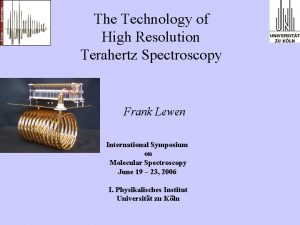Novel Periodic Solid State Devices for Terahertz Emission

- Slides: 1

Novel Periodic Solid State Devices for Terahertz Emission and Detection NIRT 0609146 : Nanostructure Components for Terahertz Spectroscopy on a Chip Greg Dyer, Jesse. Crossno*, James. Kally*, Kavir. Dass*, S. J. Allen, Gehong Zeng, and John Bowers (UC Santa Barbara) Peter Robrish, Rick Trutna, Dan Mars and Greg Lee (Agilent) * Undergrad research interns Greg Aizin (City College New York) Eric Shaner, Mike Wanke and John Reno (Sandia) Objectives DC & GHz Bias Scheme – Terahertz Emission – Terahertz gain in an electrically sold state device – Room temperature operation – Coherent radiation – m. W power – Terahertz Detection – Narrow-band response – Tunability – LN 2 or higher T operation Voltage Controlled Lateral Barrier T = 20 K – Ring and disk metal cladded resonators –Super-superlatice includes n+ doped layers to mitigate electric field domain formation Terahertz Spectroscopy Filling the Terahertz Source Gap – Quantum cascade lasers (QCLs) require cryogenic temperatures – Barrier gate biased produces potential barrier in 2 D channel – Gate controls barrier and by diode-like activation model – Electronics have low output power at high THz frequencies Resonant Response – Bloch oscillator has potential to provide tunable terahertz radiation at room temperature T = 20 K, VBG = -850 m. V –In. Sb or Si composite bolometer to detect emission (left) – Terahertz interferometer to analyze spectral content (right) Bloch Oscillations and the Stark Ladder –Equivalent views: Scattering from Bragg planes (left) or Stark ladder (right) Plasmonic Terahertz Detectors – Under negative bias, appears to be double resonance – Under positive bias, a sharp resonant feature is present Hot Electron Bolometric Response ‘opening’ of T = 20 K, n = 420 GHz –Gain without inversion Harmonic Generation and Parametric Gain – Grating gate offers tunability of electron density – Additional barrier gate increases responsivity when biased beyond pinchoff – Superlattices are highly non-linear materials – DC and/or RF bias scheme for harmonic generation (left), parametric gain (right), or LSA mode operation Sandia is a multiprogram laboratory operated by Sandia Corporation, a Lockheed Martin Company, for the United States Department of Energy under contract DE-AC 04 -94 AL 85000.

